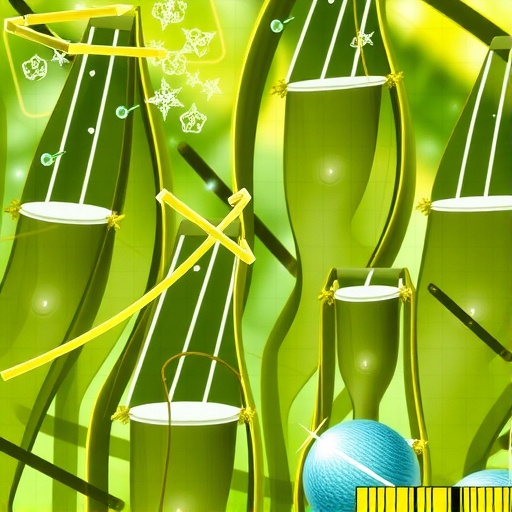In the realm of tissue engineering, the search for effective, sustainable, and ethical biomaterials has led scientists to explore innovative natural alternatives to traditional animal-derived or synthetic scaffolds. A groundbreaking study conducted by researchers from Oregon State University introduces an unexpected hero from the ocean’s depths: seaweed. This ubiquitous marine organism, often overlooked beyond its ecological and nutritional value, is now emerging as a promising, eco-friendly scaffold material for human tissue growth, specifically cardiac tissue.
The team’s research, recently published in the journal Biointerphases, delves into the potential of decellularized Pacific dulse, a species of red seaweed, as a tissue scaffold. Tissue scaffolds are structural frameworks that provide the necessary support for cells to adhere, proliferate, and differentiate into functional tissues. Historically, these scaffolds have relied heavily on animal-derived extracellular matrices or synthetic polymers. However, these materials can present problems including ethical concerns, cost, potential for immune rejection, and environmental burden.
The unique structural composition of Pacific dulse seaweed offers a natural extracellular matrix (ECM) that closely mimics the microenvironments essential for human cell growth. The research team employed a meticulous decellularization process, carefully stripping the seaweed of its native cells to preserve the ECM’s architecture. This approach ensures that the scaffolds retain their mechanical integrity and biochemical signals necessary to support the attachment and growth of human cardiomyocytes—specialized cells that contract rhythmically in heart ventricles.
One of the most critical phases of the researchers’ work involved optimizing the treatment protocols for the seaweed scaffold to maximize compatibility and minimize adverse cellular responses. By experimenting with various chemical agents, they identified sodium dodecyl sulfate (SDS), a widely used laboratory detergent, as an effective decellularization reagent. SDS treatment efficiently removed native seaweed cells while preserving the ECM proteins vital to cardiomyocyte function and viability, thereby enhancing scaffold biocompatibility.
The implications of the study extend far beyond the bench. Using seaweed-based scaffolds introduces a renewable, low-cost alternative to conventional materials that could revolutionize preclinical testing and regenerative medicine. Because these scaffolds are derived from a naturally abundant marine resource, scaling production is ethically and environmentally sustainable. Moreover, the ability to cultivate human cells on a seaweed matrix could reduce reliance on animal testing models, aligning with the growing movement for cruelty-free biomedical research.
Cardiomyocytes cultured on these seaweed scaffolds exhibited robust viability and organization into dense fibrous networks—an indicator that the scaffold effectively supported tissue maturation. This finding is particularly significant for cardiac tissue engineering, where replicating the complex extracellular environment is necessary to restore or replace damaged myocardial tissue post-infarction or in degenerative heart diseases.
An additional advantage of using seaweed lies in its inherent chemical and physical resilience. Unlike synthetic polymers that may degrade into toxic byproducts or animal matrices that carry potential antigenicity, the decellularized seaweed ECM shows inherent stability and low immunogenicity. This ensures a safer interface with human cells and reduces the risk of scaffold rejection or inflammatory responses in future clinical applications.
From the perspective of bioengineering, this study underscores the value of interdisciplinary research combining marine biology, materials science, and cellular engineering. The intricate porous architecture and biochemical composition of seaweed, long adapted by evolution to withstand oceanic forces while facilitating nutrient transport, serendipitously align with the needs of tissue scaffolding. This convergence of natural design and biomedical innovation opens new avenues for creating custom, tissue-specific scaffolds.
Furthermore, the application of seaweed scaffolds aligns with the global imperative to develop sustainable biomaterials that mitigate environmental impact. Marine biomass, unlike petroleum-based synthetics or livestock-derived materials, offers a carbon-neutral, biodegradable, and readily sourced alternative. By harnessing the ocean’s untapped potential, researchers are not only contributing to human health but also fostering a symbiotic relationship with natural ecosystems.
Looking forward, the research team plans to refine scaffold preparation protocols and explore broader applications across different tissue types, including skin, cartilage, and nerve regeneration. They also envision integrating biochemical cues and mechanical stimuli into the scaffold design to further enhance cell behavior and tissue functionality, moving closer to clinical translation.
This work exemplifies how revisiting natural, often underutilized resources through the lens of modern science can yield transformative biomedical technologies. Seaweed, a seemingly simple marine organism, may soon underpin the next generation of tissue engineering scaffolds, combining sustainability, functionality, and ethics in one green package.
As human populations grow and chronic diseases escalate, innovations like these represent a crucial step in developing regenerative therapies that are not only effective but also environmentally responsible and socially acceptable. The seaweed scaffold initiative could mark a turning point in how we approach tissue engineering, from the raw materials selection to patient outcomes.
The article “Development and optimization of decellularized seaweed scaffolds for tissue engineering” by Gobinath Chithiravelu et al., published in Biointerphases, stands at the forefront of this exciting paradigm shift, offering hope for a future where biomedical engineering harnesses the power of the natural world in clean, compassionate, and cost-effective ways.
Subject of Research: Tissue engineering using natural biomaterials; development of seaweed-derived scaffolds for cardiac cell growth.
Article Title: Development and Optimization of Decellularized Seaweed Scaffolds for Tissue Engineering
News Publication Date: October 21, 2025
Web References: https://doi.org/10.1116/6.0004685
Image Credits: Gobinath Chithiravelu
Keywords: Tissue engineering, Biomaterials, Seaweed scaffold, Decellularization, Cardiomyocytes, Biointerphases, Biocompatibility, Sodium dodecyl sulfate, Extracellular matrix, Sustainable biomaterials, Cardiac tissue regeneration, Marine-derived scaffolds




